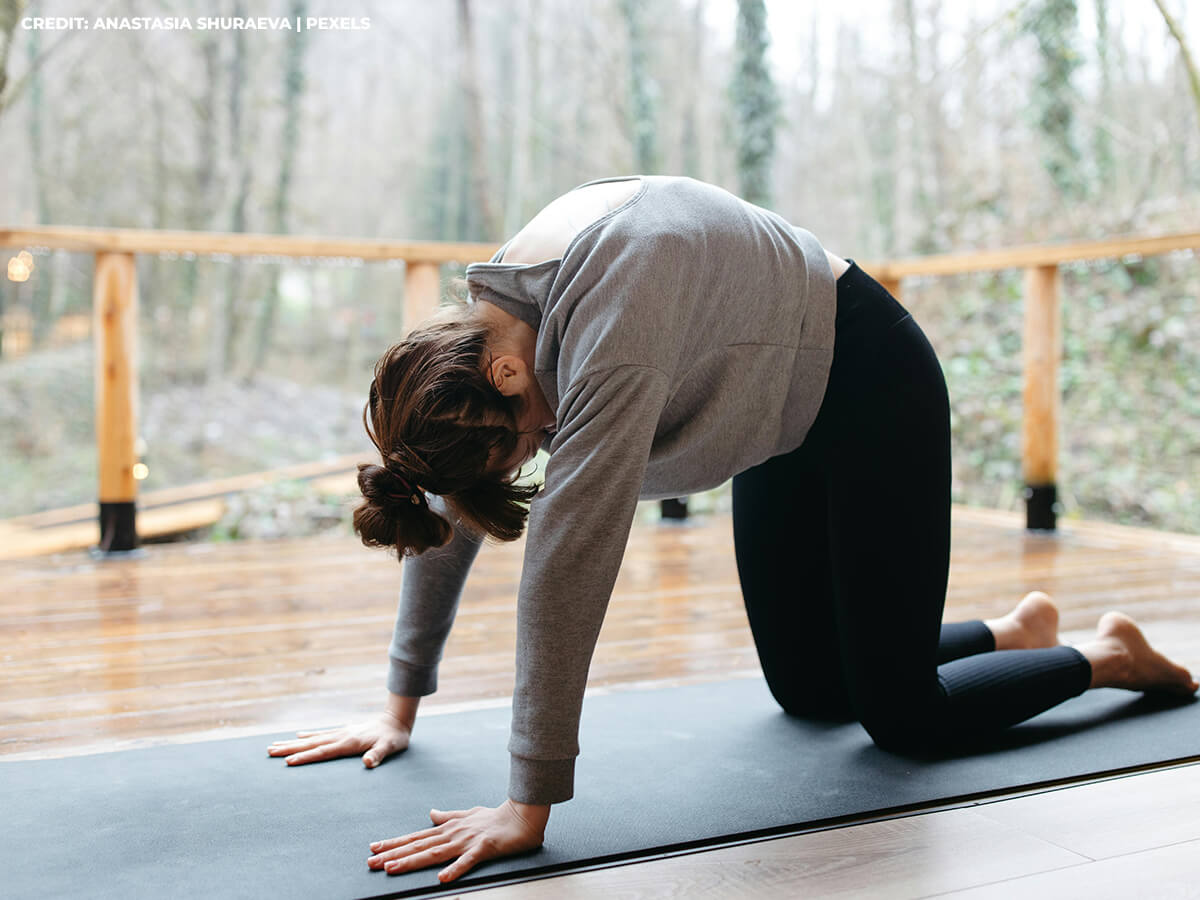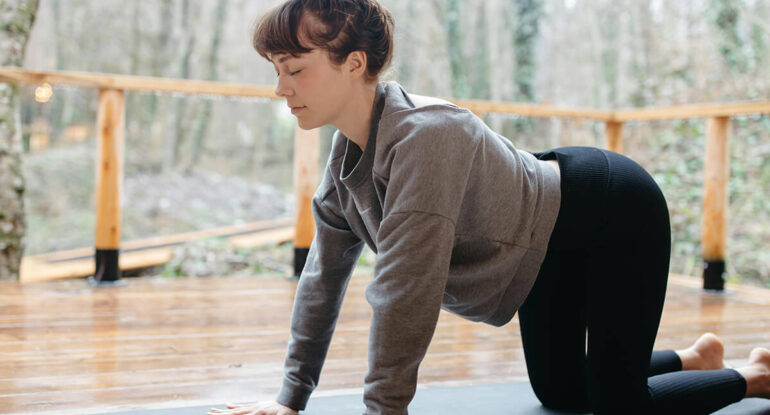Whether you experience morning stiffness, spend long hours sitting, or are simply seeking a moment of gentle release, the Cat-Cow flow can be an invaluable addition to your daily routine.
This comprehensive guide will delve into the intricacies of this movement, focusing on proper form, modifications for various needs, the crucial role of breath, and how it can contribute to overall spinal health and well-being.
Starting Position
Before embarking on the Cat-Cow flow, it’s essential to establish a stable and comfortable starting position. This ensures proper alignment and prevents unnecessary strain.
- Start on your hands and knees. Position yourself on a comfortable surface, such as a yoga mat or a carpeted floor. Ensure your hands are shoulder-width apart, with your fingers spread wide for stability. Your knees should be hip-width apart, directly beneath your hips.
- Align your joints. Check that your wrists are directly below your shoulders and your knees are directly below your hips. This alignment provides a balanced and supportive foundation for the movement.
- Maintain a neutral spine. Before initiating the flow, find a neutral spinal position. Your back should be straight, neither excessively arched nor rounded. Engage your core muscles gently to support your lower back.
- Distribute your weight evenly. Ensure your weight is distributed evenly between your hands and knees. Avoid leaning too heavily forward or backward.
- Soft gaze. Your gaze should be soft and directed downwards towards the floor between your hands. This helps to maintain a neutral neck position.
The Flow in Motion
Now that you are in the correct starting position, let’s explore the step-by-step execution of the Cat-Cow flow, emphasizing the crucial link between movement and breath.
Inhale into Cow Pose
- Initiate the movement with your breath. Begin by taking a slow, deep inhale.
- Lower your belly. As you inhale, gently allow your belly to drop towards the floor. Avoid forcing the movement; let it be a natural response to the breath.
- Arch your spine. Simultaneously, gently arch your lower back, creating a concave curve. Focus on initiating the movement from your tailbone and allowing it to travel up your spine.
- Open your chest. As your spine arches, draw your shoulder blades together and down your back. This action opens your chest forward.
- Lift your head (optional). You can gently lift your head, keeping your neck long and relaxed. Avoid crunching the back of your neck. Your gaze can be upwards or straight ahead.
- Feel the stretch. Notice the gentle stretch in your abdomen, chest, and front of your neck.
Exhale into Cat Pose
- Initiate the movement with your breath. Begin a slow, deep exhale.
- Engage your abdominal muscles. As you exhale, gently draw your navel towards your spine. This engages your core muscles and initiates the rounding of your back.
- Round your spine. Continue exhaling as you round your spine towards the ceiling, like a cat stretching its back. Allow the movement to begin in your tailbone and travel up your spine.
- Release your head. Let your head drop gently downwards, allowing your neck to relax. Your chin may tuck slightly towards your chest.
- Spread your shoulder blades. As you round your back, feel your shoulder blades spreading apart.
- Feel the stretch. Notice the stretch in your upper back, shoulders, and the back of your neck.
Continue the Flow
- Synchronize breath and movement. Continue flowing smoothly between Cow Pose on the inhale and Cat Pose on the exhale. Allow your breath to guide the rhythm of your movement.
- Focus on spinal movement. While the entire spine participates in the movement, maintain a conscious awareness of the initiation and articulation in your lower back.
- Gentle and fluid movement. Avoid jerky or forced movements. The Cat-Cow flow should feel gentle and fluid, like a wave moving through your spine. Don’t push up as hard as you can or hold an extreme pose. As soon as you get to the top you start going down to the bottom and vice versa.
- Repeat the flow. Aim for approximately seven to ten repetitions, or as long as feels comfortable and beneficial for your body to flush out the tension and swelling and stiffness through that lower back.

The Importance of Breathing
The breath is an integral component of the Cat-Cow flow, acting as the initiator and guide for the movement. Synchronizing your breath with each pose enhances the benefits of the exercise and promotes a sense of mindful awareness.
- Inhale for expansion. The inhale into Cow Pose creates space in the front of the body, mirroring the expansion of the lungs as you breathe in.
- Exhale for contraction. The exhale into Cat Pose encourages a gentle contraction in the front of the body, similar to the natural compression that occurs during exhalation.
By consciously linking your breath to the movement, you not only deepen the stretch but also calm the nervous system and cultivate a greater sense of presence in your body.
Modifications for Different Needs
The Cat-Cow flow is generally a safe and accessible exercise for most individuals. However, modifications can be helpful to accommodate specific needs or limitations.
Wrist Issues
If you experience pain or discomfort in your wrists, you can modify the pose by:
- Using your forearms. Come onto your forearms instead of your hands, keeping your elbows directly beneath your shoulders.
- Clenching your fists. If your wrists are sensitive to extension, you can practice the flow with your hands in loose fists.
- Using rolled-up mat or towels. Placing a rolled-up mat or towels under the base of your palms can reduce the angle of wrist extension.
Knee Issues
If you have sensitive knees, you can:
- Place a blanket under your knees. This provides extra cushioning and support.
- Perform the flow seated. You can adapt the Cat-Cow movement while seated in a chair. On the inhale (Cow), gently arch your back, drawing your shoulders back and lifting your chest. On the exhale (Cat), round your spine, tuck your chin towards your chest, and let your shoulders round forward.
Pregnancy
Pregnant individuals can often continue practicing a modified Cat-Cow flow. Focus on gentle movements and avoid deep arching in the lower back. Maintain a wider stance for the knees to accommodate the growing belly.
Back Pain
For individuals dealing with back pain, the Cat-Cow flow can be particularly beneficial for gentle mobilization. However, it’s crucial to listen to your body and avoid any movements that exacerbate your pain. Keep the range of motion small and focus on the gentle undulation of the spine.
Consulting with a healthcare professional is advisable for personalized guidance.
Benefits of the Cat-Cow Flow
Incorporating the Cat-Cow flow into your routine offers a multitude of physical and mental benefits:
- Warms up the spine. The gentle flexion and extension of the spine increase blood flow and prepare the body for further movement.
- Increases spinal flexibility. Regular practice helps to improve the range of motion in the spine, reducing stiffness and promoting suppleness.
- Stretches the torso, neck, and shoulders. Both the Cow and Cat poses offer gentle stretches to these areas, releasing tension that can accumulate from daily activities.
- Stimulates abdominal organs. The movement gently massages the abdominal organs, which can aid in digestion.
- Improves posture. Strengthening the back and core muscles through this flow can contribute to better posture.
- Reduces stress and calms the mind. The synchronized breath and movement can have a calming effect on the nervous system, reducing stress and promoting relaxation.
- Enhances body awareness. Paying attention to the sensations in your spine and the rhythm of your breath cultivates a deeper connection with your body.
- Releases lower back stiffness. As the initial transcription highlights, this exercise is particularly effective for addressing lower back stiffness, especially first thing in the morning. It can be a valuable component of five-minute back reset stretches.
Integrating the Cat-Cow Flow into Your Routine
The Cat-Cow flow is a versatile exercise that can be easily integrated into various routines:
- Morning warm-up. Performing a few rounds of Cat-Cow can gently awaken your spine and prepare your body for the day ahead.
- Midday break. If you spend long hours sitting, a short Cat-Cow sequence can help to release tension and improve circulation.
- Pre- or post-workout. It can serve as a gentle warm-up before more strenuous activity or as a cooling down exercise afterwards.
- Part of a yoga or stretching routine. The Cat-Cow flow is a fundamental component of many yoga sequences and can be incorporated into any stretching routine.
- Whenever you feel stiffness. Listen to your body and perform the Cat-Cow flow whenever you feel tension or stiffness in your spine.

Final Thoughts
The Cat-Cow flow is a simple yet profound practice that offers a wealth of benefits for spinal health and overall well-being. By understanding the proper form, incorporating mindful breathing, and utilizing modifications when needed, individuals of all levels can safely and effectively integrate this gentle sequence into their daily lives.
Whether you are seeking relief from lower back stiffness, aiming to improve spinal flexibility, or simply looking for a moment of mindful movement, the Cat-Cow flow provides a valuable tool for nurturing your body and cultivating a deeper connection with your breath.
For personalized guidance on managing back pain and improving spinal health, get in touch with our pain clinic in Kitchener.
Call Fairway Chiropractic Centre at 519-748-5535.











